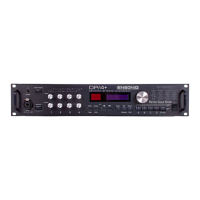Compressor
Config
Damping
De-esser
Glossary
A signal conditioning process
that
reduces a source signal's dynamic
range
.
Loud
signals
get softer
and
softer signals get
louder
. The threshold
in
this effect is
the
amplitude
level
below which a signal is
passed
without
change.
A Config (short for CONFIGuration) controls
how
the DP / 4 handles signals
by
determining the
number
of
input
sources to
be
processed,
how
they are to
be
interconnected,
and
where the
outputs
will
appear
.
There are several uses of the
term
Config
and
it is
important
to
understand
the
distinctions between them. Some terms
used
in
these definitions
may
not
yet
be
familiar,
but
they are described later
in
this section. Read these definitions
again
after
reading
the
rest of the section.
Config(uration) - This general
term
refers to the
current
signal
routing
arrangement
that
the system is using.
It
includes all
routing
parameters
.
Config
Parameter
-
Anyone
of
the
parameters
which
appear
in
Edit
mode
when
the
Config LED is
on
.
Input
Config
- The Config
parameter
which controls
how
many
input
signals are
to
be
processed
by
the DP
/4
(equivalent to
Source
Config).
Config
Preset
- The DP / 4
preset
type
which
contains algorithms
and
parameter
settings
for all of the units as well as all of the Config
parameter
settings.
u:w
Important: Setting
up
the
correct Config is
the
most
important
action
when
using
the DP /
4.
The Config controls
how
the
system
operates
in
many
important
ways.
It
is very important to
understand
this concept clearly in
order
to
avoid
later
confusion.
Please read the rest of this section
and
then
refer to
Section
3 - Config
Parameters
for more details
on
this essential concept.
A
parameter
in
the
DP
/ 4
that
allows control of frequency information
found
in
reverb
algorithms. You can use
damping
to customize the perceived size
and
ambience of
an
environment (making it
wetter/
drier or
brighter/
darker).
A specialized algorithm
that
reduces the level of sibilance
in
a source signal
through
selective
high
frequency compression. This sibilance is usually
heard
as
an
"s"
sound
in
speech, hence the
name
De-esser.
Digital Delay Line (DDL)
An
algorithm
that
causes source signals to
be
moved
in
time relative to the
original signal.
These"
delayed" signals are
used
to create a
myriad
of
audio
effects,
such
as echo
and
reverb.
Dual Mono
A
term
used
in
the DP / 4 to describe one signal
routing
option. Two
inputs
are treated as
separate
mono
signals
rather
than
as a stereo
pair
. This option processes
the
two
input
sources as two discrete
mono
outputs
. A useful
option
when
more
individual
effects are
needed.
Early Reflections Early reflections create the sonic information
that
determines
how
we
localize
and
perceive size
in
ambient spaces.
In
the case of a room,
where
the signal is
bounced
off all
surfaces (walls/ceiling/floor),
the
perception of
the
summation
of these
delayed
signals
creates
what
we
term ambience.
In
the
DP
/4,
you
can control these delays to create
various environments.
Echo
XVI
A delay
that
is perceived as a discrete
repeat
of
the
original sound. A classic example of
an
echo is the effect of
shouting
into a canyon. You will
hear
your
voice
delayed
and
repeated throughout the canyon. Generally, echoes are created
by
long
delay
times.
ENSONIQ DP/4 Musician's Manual
--..

